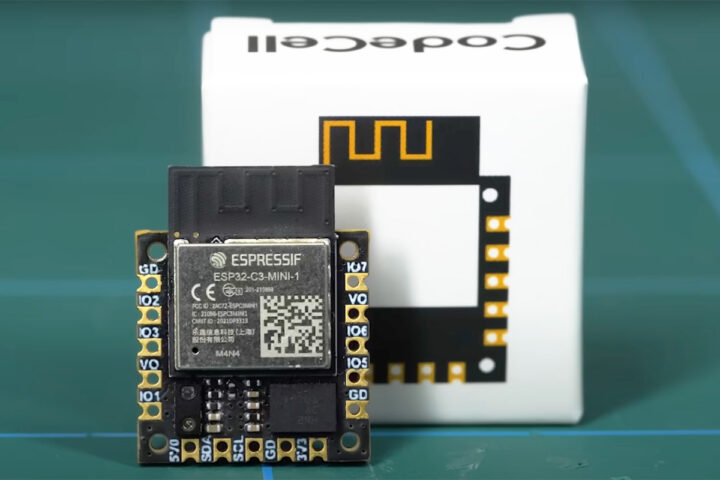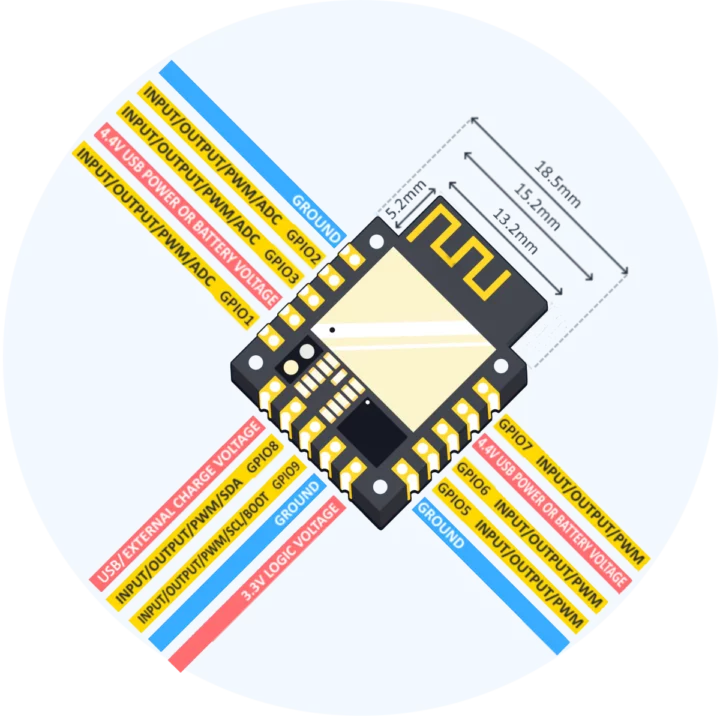Engineer and YouTuber Carl Bugeja recently developed CodeCell, a tiny ESP32-C3 development board designed as the brain for robots, wearables, and smart home devices. This module features a nine-axis inertial measurement unit (IMU) for motion fusion and an optional VCNL4040 light sensor. It includes a USB Type-C port for data and power as well as a lithium-polymer battery with a charging circuit.
Measuring just 18.5 x 18.5mm this compact board is even smaller than other tiny ESP32 development boards such as Waveshare’s ESP32-S3-Zero and Seeed Studio’s XIAO ESP32S3. However, the Epi C3 is smaller at 23 x 12.75 mm, and so are the Unexpected Maker NANOS3 (25 x 10 mm) and Unexpected Maker OMGS3 (28 x 11 mm).
CodeCel ESP32-C3 mini development board specification
- Microcontroller – ESP32-C3 RISC-V MCU
- 160MHz 32-bit RISC-V processor core
- 400kB SRAM, 4MB flash storage
- Wi-Fi 4 and Bluetooth Low Energy (BLE) connectivity
- Sensors
- Vishay VCNL4040 light sensor
- Optional CEVA BNO085 nine-axis inertial measurement unit (IMU) for motion fusion
- USB – USB Type-C port for power and data
- Battery – Integrated lithium-polymer (LiPo) battery charging circuit
- I/Os
- Castellated 0.1” pin headers on three sides
- Multiple GPIO pins for peripheral expansion
- Dimensions – 18.5 x 18.5mm PCB (plus 5.2mm antenna)
CodeCell can be programmed using the Arduino IDE. The video provides instructions on setting up the IDE, installing the necessary libraries, and uploading code to the device. It also covers basic functions and examples for using the sensors and GPIO pins. In the video, he also mentions a full written guide about CodeCell’s hardware and software to simplify things to get started.
To make things easier Bugeja has created various example projects with CodeCell including depth gesture recognition, tap detection recognition, proximity sensing, automatic dimming, a step counter, angle control, and much more which can be found in the ‘CodeCell.h’ library.
The CodeCell kit includes a 70mAh 20C LiPo battery measuring 23 x 17.5 x 8.7 mm and weighing 4.6 grams. It’s equipped with a 1.25mm female connector that plugs directly into the onboard port. The PCB is ROHS compliant and adheres to the IPC-A-600 II standard, ensuring quality and safety. The CodeCell is designed as a DIY maker kit; if you have plans to use this for commercial applications, you can get in touch with microbots for more information.
The CodeCell is available on Bugeja’s Microbots store with the light-only version going for €12.50 or $13.50, and the light-and-motion model selling for €29.99 or $32.
Via Hackster.io
Debashis Das is a technical content writer and embedded engineer with over five years of experience in the industry. With expertise in Embedded C, PCB Design, and SEO optimization, he effectively blends difficult technical topics with clear communication
Support CNX Software! Donate via cryptocurrencies, become a Patron on Patreon, or purchase goods on Amazon or Aliexpress






